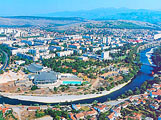Montenegro
The SpecialEasts on the road for you:
Western europe. Eastern europe. Balkans. Turkey. CIS. Middle East. Central Asia.

Zenit offers the following services for Montenegro:
You need to transport goods from or to Montenegro? Just give us a call.
Our team will find the right solution for you!
Montenegro - brief overview about the Zenit destination Montenegro.
Geopraphy

Internationally, Montenegro borders Croatia, Bosnia and Herzegovina, Serbia, Kosovo,[a] and Albania. It lies between latitudes 41° and 44°N, and longitudes 18° and 21°E.
Montenegro ranges from high peaks along its borders with Serbia, Kosovo,[a] and Albania, a segment of the Karst of the western Balkan Peninsula, to a narrow coastal plain that is only 1.5 to 6 kilometres (1 to 4 miles) wide. The plain stops abruptly in the north, where Mount Lovćen and Mount Orjen plunge into the inlet of the Bay of Kotor.
Montenegro's large Karst region lies generally at elevations of 1,000 metres (3,280 ft) above sea level; some parts, however, rise to 2,000 m (6,560 ft), such as Mount Orjen (1,894 m or 6,214 ft), the highest massif among the coastal limestone ranges. The Zeta River valley, at an elevation of 500 m (1,600 ft), is the lowest segment.
The mountains of Montenegro include some of the most rugged terrain in Europe, averaging more than 2,000 metres (6,600 feet) in elevation. One of the country's notable peaks is Bobotov Kuk in the Durmitor mountains, which reaches a height of 2,522 m (8,274 ft). Owing to the hyperhumid climate on their western sides, the Montenegrin mountain ranges were among the most ice-eroded parts of the Balkan Peninsula during the last glacial period
Demographics

According to 2003 census, Montenegro has 620,145 citizens. If the
methodology used up to 1991 had been adopted in the 2003 census, Montenegro
would officially have recorded 673,094 citizens. Most recent estimates stake
somewhere below 700,000 inhabitants.
When the census was taken Montenegro was
a non-national civic state. In the meantime, the Constitution was changed, hence
it now recognizes the major ethnic groups living in it: Montenegrins, Serbs,
Bosniaks, Muslims, Albanians and Croats. Thus, the number of "Montenegrins" and
"Serbs" fluctuates wildly from census to census, not due to real changes in the
populace, but due to changes in how people experience their identity.
Ethnic
composition according to the 2004 official data:
Total 620,145. Montenegrins 267,669, 43.16%, Serbs
198,414 31.99%, Bosniaks 48,184, 7.77%, Ethnic Muslims 36,479, 5.07%,
Albanians 24,163, 3.01%, Croats 6,811, 1.1%, Roma 2,601, 0.42%, Yugoslavs 1,860,
0.3%, Italians 500,0.08%, others 38,818, 6.18%. According the newest report,
there are 24,610 total refugees from the Yugoslav wars in Montenegro, forming
4.2% of the total population. 16,136 are refugees from Kosovo after 1999 and
8,474 expelled from Croatia and Bosnia.
Economy
The economy of Montenegro is mostly service-based market economy in late
transition. According to IMF, nominal GDP of Montenegro was $4.822 billion in
2008. The GDP PPP for 2008 was $6.944 billion, or $11,111 per capita. Although
GDP grew at impressive 10,7% in 2007, a slowdown is expected due to late-2000s
recession. In 2007, service sector made up for 72,4% of GDP, industry was
second largest contributor with 17,6%, trailed by agriculture at 10%. According
to Eurostat data, Montenegrin PPS GDP per capita stood at 46 per cent of the EU
average in 2008. Aluminum and steel production and agricultural processing make
up for most of Montenegrin industry.
Tourism is an important contributor to
Montenegrin economy. Approximately one million tourists visited Montenegro in
2007, resulting in 480 million of tourism revenue. Tourism is the backbone of
future economic development strategy for Montenegro. The growth of the
Montenegrin economy may be hampered by significant dependence on foreign direct
investment, and thus susceptibility to external shocks and high export/import
trade deficit.
Climate
The mountains of Montenegro include some of the most rugged terrain in Europe, averaging more than 2,000 metres (6,600 feet) in elevation. One of the country's notable peaks is Bobotov Kuk in the Durmitor mountains, which reaches a height of 2,522 m (8,274 ft). Owing to the hyperhumid climate on their western sides, the Montenegrin mountain ranges were among the most ice-eroded parts of the Balkan Peninsula during the last glacial period
Infrastructure

Montenegrin road infrastructure is not on par with European standards. Despite an extensive road network no roads are built to full motorway standards, though two current roadway projects projects, the Bar - Boljare motorway and the Montenegrin section of Adriatic Ionian motorway, should change this. Construction of these motorways is considered a national priority, as both are important for uniform regional economic development and the development of Montenegro as an elite tourist destination.
Current European routes that pass through Montenegro are E65 and E80. The backbone of the Montenegrin rail network is the Belgrade - Bar railway. This railway intersects with Nikši? - Tirana(Albania) at Podgorica, however, this railway is not used for passenger service. Montenegro has two international airports, Podgorica Airport and Tivat Airport. The two airports served 1,1 million passengers in 2008. Montenegro Airlines is the flag carrier of Montenegro.
The Port of Bar is Montenegro's main seaport.
More Information: http://en.wikipedia.org/wiki/Montenegro
Text is available under the Creative Commons Attribution-ShareAlike License; additional terms may apply. See Terms of Use for details.
Wikipedia® is a registered trademark of the Wikimedia Foundation, Inc., a non-profit organization.

 Deutsch
Deutsch Turkce
Turkce Russian
Russian